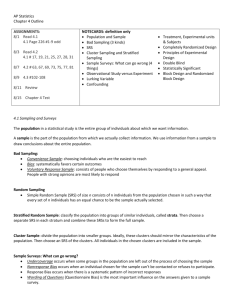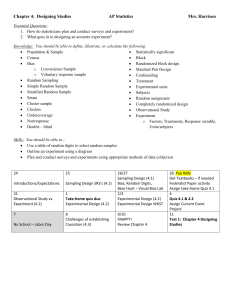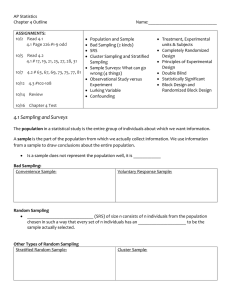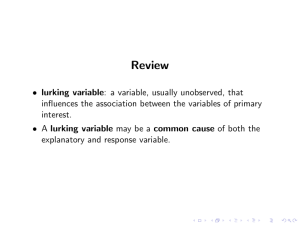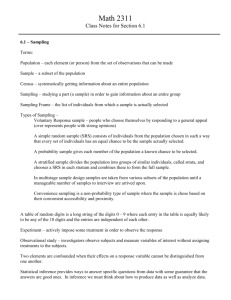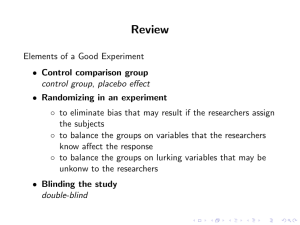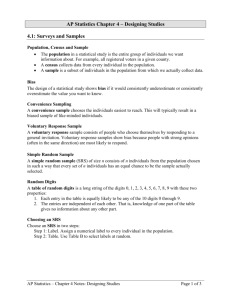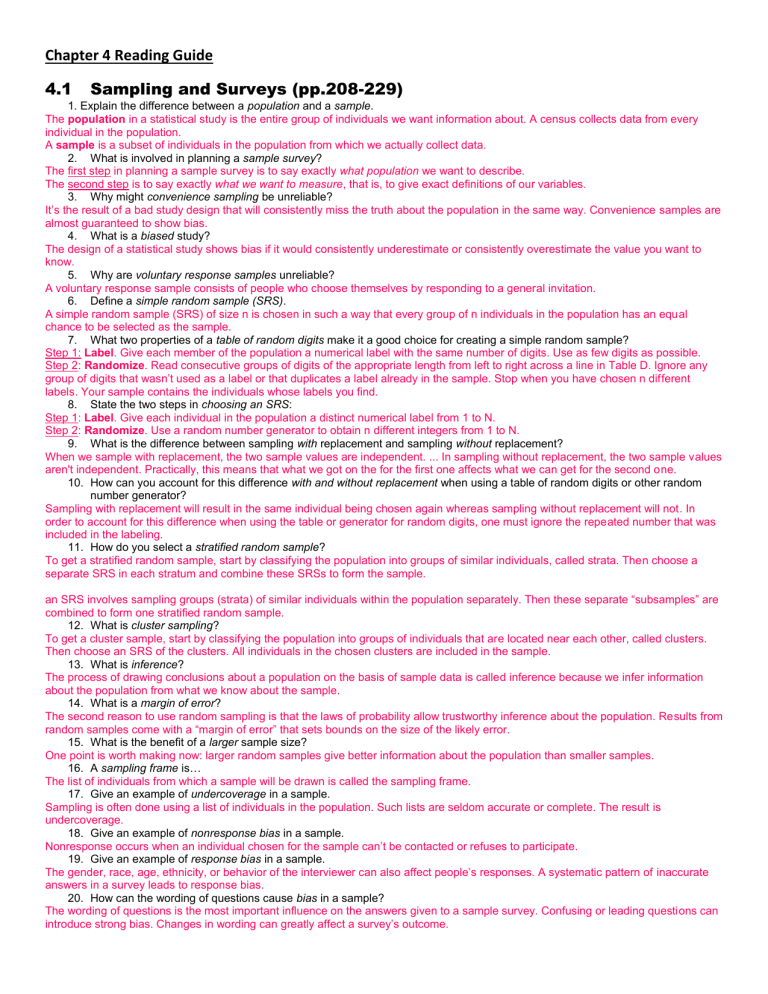
Chapter 4 Reading Guide 4.1 Sampling and Surveys (pp.208-229) 1. Explain the difference between a population and a sample. The population in a statistical study is the entire group of individuals we want information about. A census collects data from every individual in the population. A sample is a subset of individuals in the population from which we actually collect data. 2. What is involved in planning a sample survey? The first step in planning a sample survey is to say exactly what population we want to describe. The second step is to say exactly what we want to measure, that is, to give exact definitions of our variables. 3. Why might convenience sampling be unreliable? It’s the result of a bad study design that will consistently miss the truth about the population in the same way. Convenience samples are almost guaranteed to show bias. 4. What is a biased study? The design of a statistical study shows bias if it would consistently underestimate or consistently overestimate the value you want to know. 5. Why are voluntary response samples unreliable? A voluntary response sample consists of people who choose themselves by responding to a general invitation. 6. Define a simple random sample (SRS). A simple random sample (SRS) of size n is chosen in such a way that every group of n individuals in the population has an equal chance to be selected as the sample. 7. What two properties of a table of random digits make it a good choice for creating a simple random sample? Step 1: Label. Give each member of the population a numerical label with the same number of digits. Use as few digits as possible. Step 2: Randomize. Read consecutive groups of digits of the appropriate length from left to right across a line in Table D. Ignore any group of digits that wasn’t used as a label or that duplicates a label already in the sample. Stop when you have chosen n different labels. Your sample contains the individuals whose labels you find. 8. State the two steps in choosing an SRS: Step 1: Label. Give each individual in the population a distinct numerical label from 1 to N. Step 2: Randomize. Use a random number generator to obtain n different integers from 1 to N. 9. What is the difference between sampling with replacement and sampling without replacement? When we sample with replacement, the two sample values are independent. ... In sampling without replacement, the two sample values aren't independent. Practically, this means that what we got on the for the first one affects what we can get for the second one. 10. How can you account for this difference with and without replacement when using a table of random digits or other random number generator? Sampling with replacement will result in the same individual being chosen again whereas sampling without replacement will not. In order to account for this difference when using the table or generator for random digits, one must ignore the repeated number that was included in the labeling. 11. How do you select a stratified random sample? To get a stratified random sample, start by classifying the population into groups of similar individuals, called strata. Then choose a separate SRS in each stratum and combine these SRSs to form the sample. an SRS involves sampling groups (strata) of similar individuals within the population separately. Then these separate “subsamples” are combined to form one stratified random sample. 12. What is cluster sampling? To get a cluster sample, start by classifying the population into groups of individuals that are located near each other, called clusters. Then choose an SRS of the clusters. All individuals in the chosen clusters are included in the sample. 13. What is inference? The process of drawing conclusions about a population on the basis of sample data is called inference because we infer information about the population from what we know about the sample. 14. What is a margin of error? The second reason to use random sampling is that the laws of probability allow trustworthy inference about the population. Results from random samples come with a “margin of error” that sets bounds on the size of the likely error. 15. What is the benefit of a larger sample size? One point is worth making now: larger random samples give better information about the population than smaller samples. 16. A sampling frame is… The list of individuals from which a sample will be drawn is called the sampling frame. 17. Give an example of undercoverage in a sample. Sampling is often done using a list of individuals in the population. Such lists are seldom accurate or complete. The result is undercoverage. 18. Give an example of nonresponse bias in a sample. Nonresponse occurs when an individual chosen for the sample can’t be contacted or refuses to participate. 19. Give an example of response bias in a sample. The gender, race, age, ethnicity, or behavior of the interviewer can also affect people’s responses. A systematic pattern of inaccurate answers in a survey leads to response bias. 20. How can the wording of questions cause bias in a sample? The wording of questions is the most important influence on the answers given to a sample survey. Confusing or leading questions can introduce strong bias. Changes in wording can greatly affect a survey’s outcome. 4.2 Experiments (pp.234-258) 1. Explain the differences between observational study and experiment. An observational study observes individuals and measures variables of interest but does not attempt to influence the responses. An experiment deliberately imposes some treatment on individuals to measure their responses. 2. A lurking variable is… A lurking variable is a variable that is not included as an explanatory or response variable in the analysis but can affect the interpretation of relationships between variables. A lurking variable can falsely identify a strong relationship between variables or it can hide the true relationship. 3. What problems can lurking variables cause? lurking variables can falsely show a strong relationship between two variables and it can also hide the relationship existing between two variables. They cause the correlation analysis or the regression analysis to mislead the researcher. 4. Confounding occurs when… Confounding occurs when two variables are associated in such a way that their effects on a response variable cannot be distinguished from each other. 5. Answer the four questions for the Check Your Understanding on page 237 ● Does reducing screen brightness increase battery life in laptop computers ● Was this an observational study or an experiment ● What are the explanatory and response variables ● Explain clearly why such a study cannot establish a cause-and-effect relationship. Suggest a variable that may be confounded with whether families eat dinner together. 6. Explain the difference between experimental units and subjects. The experimental units are the smallest collection of individuals to which treatments are applied. When the units are human beings, they often are called subjects. 7. Define treatment. A specific condition applied to the individuals in an experiment is called a treatment. If an experiment has several explanatory variables, a treatment is a combination of specific values of these variables. 8. By studying the TV Advertising example on page 239, identify the factors and levels in the experiment. Factors: Levels: 9. What is random assignment? In an experiment, random assignment means that experimental units are assigned to treatments using a chance process. 10. What is a comparative experimental design? An experimental design in which two samples or populations exposed to different conditions or treatments are compared to each other. 11. In a completely randomized design… In a completely randomized design, the experimental units are assigned to the treatments completely by chance. 12. Does using chance to assign treatments in an experiment guarantee a completely randomized design? Explain. No. The problem comes if we try to force the two groups to have equal sizes. Suppose we let the coin-tossing continue until one of the groups has 25 students and then place the remaining students in the other group. This is no longer a completely randomized design because the last few students aren’t being assigned to one of the treatments by chance. In fact, these students will all end up in the same group, which could lead to bias 13. What is the significance of using a control group? Without such a control group, we wouldn’t be able to compare the experimental units. 14. The basic principles of statistical design experiments are: The basic principles of statistical design of experiments are control, replication, and randomization. 15. Define control, random assignment and replication in experimental design. a control is an element that remains unchanged or unaffected by other variables. Random assignment refers to the use of chance procedures in psychology experiments to ensure that each participant has the same opportunity to be assigned to any given group. Replication means that you need to use enough experimental units to distinguish a difference in the effects of treatments from chance variation due to the random assignment. *Replication means repeatability 16. Describe the placebo effect. The response to a dummy treatment is called the placebo effect. 17. What are the differences between a double-blind and single-blind experiment? In a double-blind experiment, neither the subjects nor those who interact with them and measure the response variable know which treatment a subject received. Such an experiment can still be single-blind if the individuals who are interacting with the subjects and measuring the response variable don’t know who is dieting and who is exercising. In other single-blind experiments, the subjects are unaware of which treatment they are receiving, but the people interacting with them and measuring the response variable do know. 18. Define statistically significant. An observed effect so large that it would rarely occur by chance is called statistically significant. 19. What is a block? A block is a group of experimental units that are known before the experiment to be similar in some way that is expected to affect the response to the treatments. 20. What is a randomized block design? In a randomized block design, the random assignment of experimental units to treatments is carried out separately within each block. 21. When does randomization take place in a block design, and how does this differ to a completely randomized design? Randomization happens after they are blocked, in order to get rid of bias. 22. What is the goal of a matched pairs design? A common type of randomized block design for comparing two treatments is a matched pairs design. The idea is to create blocks by matching pairs of similar experimental units. 23. When is it beneficial to use a blocked/paired design? How should we choose which variables to block for? Because this design reduces variability and potential confounding, it produces a better estimate of treatment effects 4.3 Using Studies Wisely (pp.266-273) 1. Name the two types of inferences that can be identified based on the design of a study. (inferences about the population and inferences about cause-and- effect) 2. Name the challenges of establishing causation. A well-designed experiment tells us that changes in the explanatory variable cause changes in the response variable. More precisely, it tells us that this happened for specific individuals in the specific environment of this specific experiment. A serious threat is that the treatments, the subjects, or the environment of our experiment may not be realistic. Lack of realism can limit our ability to apply the conclusions of an experiment to the settings of greatest interest. 3. What are the four criteria for establishing causation when we can’t do an experiment? ● The association is strong. ● The association is consistent. ● Larger values of the explanatory variable are associated with stronger responses. ● The alleged cause precedes the effect in time. ● The alleged cause is plausible. 4. Briefly describe the basics of data ethics. All planned studies must be reviewed in advance by an institutional review board charged with protecting the safety and well-being of the subjects. All individuals who are subjects in a study must give their informed consent before data are collected. All individual data must be kept confidential. Only statistical summaries for groups of subjects may be made public.
